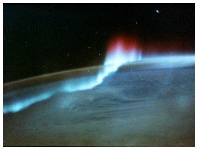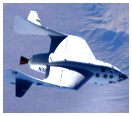
 Way Up High - There's Light In the Sky When we see the Northern Lights in the Arctic regions, they seem to shoot down from the sky and almost touch the ground. When viewed from space (as astronauts in the space shuttle see them), the auroras look more like curtains of light - hooked to the Earth's surface and hanging out into space. In fact, the Northern Lights begin far above the Earth's surface. Jet planes fly at a height of about 5 miles / 8 km, but the auroras begin even higher than that - much higher!
That's about where the bottom edges of the auroras start. They then extend upwards, with the tops sometimes reaching a height of 600 miles / 965 km. So... even though the Northern Lights seem to touch the ground, that is just an illusion. PICTURE: Space shuttles travel in a "low earth" orbit about 150 miles / 250 kilometers above the Earth's surface, providing a great view of the Northern Lights. Northern Lights SLIDE SHOW
Click pictures for more information and credits. Library: Arctic, Northern Lights Environment/Atmosphere Links: Arctic, Northern Lights Guide to Arctic Sunrise & Sunset Arctic Maps & Weather Reports |

|
DICTIONARY: Just "double-click" any unlinked word on this page for the definition from Merriam-Webster's Student Electronic Dictionary at Word Central. |

|
ARCTIC LIBRARY & GLOSSARY: Check this section for an index of the rest of the things you really need to know about the Arctic. |

|
ARCTIC MAPS & WEATHER REPORTS: Maps of the Northwest Passage, explorers' routes, iceberg sources, Nunavut, the Arctic by treeline, temperature... |

|
ARCTIC LINKS: Even more information! Links to sites related to the Arctic and "Iceberg: the Story of the Throps and the Squallhoots". |

|
GUIDE TO ARCTIC SUNRISE & SUNSET: How much sunlight or darkness is there in the Arctic on each day of the year? |
to is the property of their respective owners, and Athropolis is not responsible for their content.
